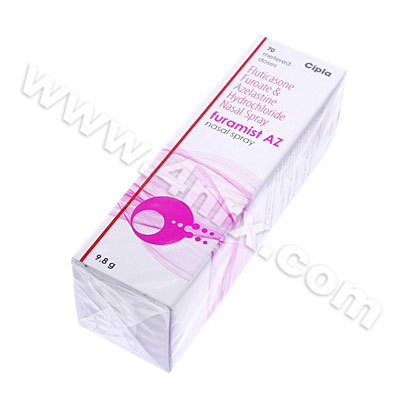 |
Home  Allergies Allergies  Furamist AZ Nasal Spray (Azelastine/Fluticasone) Furamist AZ Nasal Spray (Azelastine/Fluticasone) |
|
|||||||||
|
Furamist AZ Nasal Spray (Azelastine/Fluticasone)
What is Furamist AZ Nasal Spray (Azelastine/Fluticasone) used for? Furamist AZ Nasal Spray (Azelastine/Fluticasone) is used to help treat and manage the symptoms of allergic rhinitis. It contains the active ingredients fluticasone, which is an anti-inflammatory, and azelastine, an antihistamine. By helping to inhibit the activity of histamine and reduce inflammation, this nasal spray is effective in providing relief from the symptoms of rhinitis. How should I use Furamist AZ Nasal Spray (Azelastine/Fluticasone)? Furamist AZ Nasal Spray (Azelastine/Fluticasone) should be administered directly to the nose. Patients should gently blow their nose first. The nozzle may then be placed in the nose, and the prescribed amount of sprays delivered. After spraying, the patient should inhale through the nose, and exhale through the mouth. It is important not to blow the nose for at least 15 minutes after using the spray. Adults and children over 12 are usually directed to deliver one spray into each nostril twice per day, unless your physician prescribes a different dosage to you. Never exceed the prescribed dosage. What are the side effects of Furamist AZ Nasal Spray (Azelastine/Fluticasone)? Some side effects which have been reported by patients using Furamist AZ Nasal Spray (Azelastine/Fluticasone) include:
Consult your physician immediately if any of these side effects persist or worsen. Please Note Strictly follow all instructions provided to you by your physician or pharmacist while using Furamist AZ Nasal Spray (Azelastine/Fluticasone). Optimum and safe dosage can differ based on the patient and the condition being treated. As this medication may be unsafe for certain patients, it is essential you always inform your physician if you are pregnant or breastfeeding, as well as if you have any allergies, other illnesses, or ongoing health conditions, and if you are taking any other form of medication, supplements, or herbal products. Immediately seek emergency medical care if you have any allergic or hypersensitive reaction. Common signs of a reaction include hives, swelling, skin rashes, chest pains, as well as trouble breathing or swallowing. 
|
|||||||||||||||||